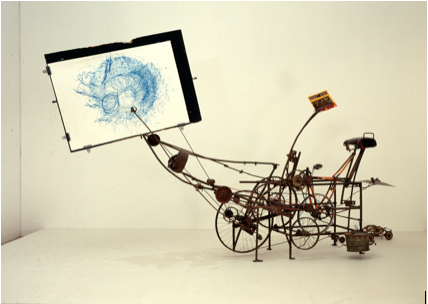“The computer is a unique device for the arts since it can function solely as an obedient tool with vast capabilities for controlling complicated processes, but then again, full exploitation of these unique talents for controlled randomness and detailed algorithms could result in an entirely new medium- a creative artistic medium.” – Micheal Noll
I really enjoyed this presentation by Casey Reas, and I was particularly fascinated by the idea of using code to create generative art where you’re able to control randomness. I especially liked ‘The Tissue Work‘, which was built around ideas from a book by neuroanatomist Valentino Braitenberg. By using software, Reas built a simulation of these conceptual vehicles, and what was interesting was that order began to emerge within their patterns and behaviors over time. To simulate this process, they used order with “a little bit of chance”.
I found the concept of limiting and controlling the amount of randomness in computer art pieces really interesting, and it’s an element that I want to attempt to add to my piece for this week’s assignment, where we are replicating pieces from old issues of a Computer Graphics and Art magazine. Reas mentioned that in one of his projects, they used randomness as a “jumping off point” and I like the idea of utilizing randomness in art as a means of exploring what you can do, but not letting it take up too much of the work’s identity, in a way.
When Reas was talking about chance in art, he provided a few early examples of artists whose works reflect that notion, such as Dada artist Jean Tinguely’s Meta-Matics, a series of machines which automatically produce infinite sequences of drawings:
I really liked this example, especially given that at the time it was made, it was created in response to the then growing commercialization of art and to question the role of the artist amidst the “threat” of industrialization and mass-production. But today, this work has acquired more meaning and it can also be viewed in relation to the idea of exploring technology’s potential as a new medium for art, rather than a substitute.
